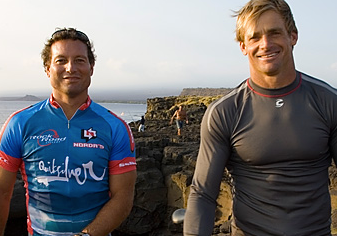Paddleboarding Basics and Terminology
Stance: In a comfortable paddleboarding stance you will want to have your feet shoulder length apart, toes facing the nose of the board. The key is to be light on your feet at the point of the stroke when you place the most power. Your weight should be distributed evenly when you paddle and beginners who are standing up for their first time should be careful about placing too much weight on their toes. A staggered stance (placing one foot back on the side you are paddling on) is an intermediate foot position used for speed and is also the foundation for pivot turns (using your back foot to turn the board 180 degrees). Another important part of the stance is where to stand. In general you will want to stand where the handle of the board is because this is generally the center point. If you are paddling into the wind move your stance back behind the center point so that the nose of the board is higher. If you get into paddleboard racing, a racing stance is slightly narrower than shoulder length apart to reduce weight on the rails of the board to maximize speed.
Stroke: There are 3 basic parts that make up a paddleboard stroke: The Catch, Power and Release. The catch is the moment when you place your paddle blade in the water and immediately after the catch is your power phase. When your blade reaches your feet is when you want to release your paddle out of the water, feather your paddle slightly and then repeat. A proper stroke takes years to master and the important thing to keep in mind is that you are not using your arms for power. A proper stroke is when your entire body is working together in unison.
Speed is a measure of distance per stroke, which goes hand-in-hand with the stroke rate, or how many times you can complete one stroke usually measured by the minute. An average stroke rate is 30-40 strokes/ minute and a fast, racing rate is 50-60 +. There are 2 types of paddle strokes that you can use for speed- the Hawaiian and the Tahitian, or an emphasis on power and distance vs. an emphasis on stroke rate. In our intermediate and advanced classes we will teach you that the ideal stroke rate is a combination of these two methods.
Having the right equipment and the right size equipment is just as important as having a proper stroke. The two go hand in hand; you can’t have one without the other.
SUP Boards: There are a couple different types of paddle boards including recreational, inflatable, and displacement hull “racing boards.” Your first step on the water will be to rent or purchase a recreational board. These boards generally come in 2 sizes: 10’6 or 11’6 and can be used for a wide range of SUP activities including: all around paddling, ocean surfing, fitness and yoga. As you progress in skill there comes the need for speed available in racing/ touring board models with a displacement hull and narrow design. A displacement hull design is similar to a boat hull design, rounded on the bottom displacing water to the sides of the board. These boards are available in 12’6 and 14 in length, which along with unlimited, are the two standard classes in paddleboard racing (great info about sup racing available at supracer.com)
Paddles: The area of most improvement that we see on the water is with new paddlers who do not have the right size paddle. Having a good quality paddle, one that is light and feels comfortable in your hands with a soft EVA grip, one that catches and releases with ease, might be the biggest game-changer in the sport. The paddle consists of 3 basic parts including the blade, the shaft and the grip, or handle. In general, the bigger the paddler, the bigger the blade that is needed. We recommend starting off with an adjustable paddle to figure out a length that is comfortable for you. At DFW Surf, we are proud to be an official dealer for Quickblade Paddles.
 One of the first paddlers in Texas, Matt Thomson, who, in 2005, decided to stand up on his windsurfboard with a canoe paddle.
One of the first paddlers in Texas, Matt Thomson, who, in 2005, decided to stand up on his windsurfboard with a canoe paddle. Paddle pioneers Dave Kalama and Laird Hamilton.
Paddle pioneers Dave Kalama and Laird Hamilton.